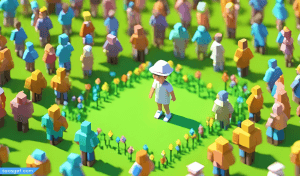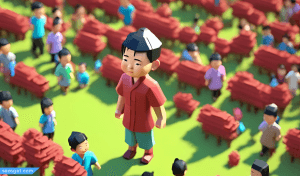How to Make an AI Image Generator, you need machine learning skills and access to a robust dataset. Use frameworks like TensorFlow or PyTorch.
Creating an AI image generator is an exciting venture in the field of artificial intelligence. These tools can transform text descriptions into vivid, lifelike images. The process involves training a neural network on a large dataset of images. Popular frameworks like TensorFlow and PyTorch can facilitate this.
You must preprocess data, design the architecture, and fine-tune the model for optimal performance. Proper training and validation ensure high-quality results. This technology has vast applications, from art to marketing, making it a valuable skill in today’s digital world.
Introduction To Ai Image Generators
AI Image Generators are changing the way we create pictures. These tools use artificial intelligence to make new images from scratch. They can turn simple sketches into detailed artworks. Understanding how these generators work can open doors to endless creative possibilities.
What Is An Ai Image Generator?
An AI Image Generator is a software program. It uses algorithms to create images. These algorithms learn from a large set of data. This data includes many different types of pictures. The generator can then produce new images that look like the examples it learned from.
There are different types of AI Image Generators. Some focus on creating realistic images. Others create abstract or artistic ones. The most common types are Generative Adversarial Networks (GANs) and Variational Autoencoders (VAEs).
Applications Of Ai Image Generators
AI Image Generators have many uses. They are used in art, design, and entertainment. Artists use them to create new styles of art. Designers use them to make unique graphics. In entertainment, they help create characters and scenes for movies and games.
Businesses also find them useful. They can create marketing materials quickly. They are used in product design to visualize new ideas. Here are some common applications:
- Art and Design: Creating new artworks and designs.
- Entertainment: Designing characters and scenes.
- Marketing: Making promotional images.
- Product Design: Visualizing new products.
Choosing The Right Tools
Creating an AI image generator can seem daunting. Choosing the right tools makes it easier. This guide will help you pick the best tools.
Programming Languages
Selecting the right programming language is crucial. Here are some popular choices:
- Python: Most popular for AI projects. Easy to learn and has many libraries.
- R: Good for statistical analysis and data visualization.
- Java: Offers strong performance and portability.
- C++: Known for speed and efficiency. Great for complex models.
Frameworks And Libraries
Frameworks and libraries simplify the development process. Here are some essential ones:
| Framework/Library | Description |
|---|---|
| TensorFlow | Open-source library by Google. Ideal for deep learning. |
| Keras | User-friendly API for building neural networks. Runs on top of TensorFlow. |
| PyTorch | Developed by Facebook. Known for dynamic computation graphs. |
| OpenCV | Open-source computer vision library. Useful for image processing. |
Choosing the right tools sets the foundation for your project. It makes development smoother and more efficient.
Data Collection
Creating an AI image generator requires a robust dataset. Data collection is the backbone of any AI project. Proper data collection ensures your AI model works efficiently. This section will explore the types of data needed and where to source them.
Types Of Data Needed
To build an AI image generator, you need diverse image data. The main types of data are:
- Images: High-quality images are essential.
- Labels: Each image should have a label. This helps the AI understand what it sees.
- Metadata: Information about the image, like size and color.
Quality and variety are crucial in data collection. Diverse data leads to a more versatile AI model.
Sources For Image Data
Finding quality image data can be challenging. Here are some recommended sources:
- Public Datasets: Many websites offer free image datasets. Examples include Kaggle and Google Dataset Search.
- Web Scraping: You can collect images directly from the web. Tools like BeautifulSoup can help.
- Stock Photo Websites: Websites like Unsplash and Pexels offer free images.
- User-Generated Content: Encourage users to upload images. This can expand your dataset.
Ensure you follow copyright laws while collecting data. Use only public domain images or images with proper licenses.
Data Preprocessing
Data preprocessing is a crucial step in building an AI image generator. It ensures the raw data is clean and suitable for training the AI model. This step involves cleaning the data and applying data augmentation techniques to enhance the dataset.
Cleaning The Data
Cleaning the data is the first step. Start by removing any corrupted or incomplete images. These images can negatively impact the model’s performance.
Next, ensure all images are in the same format and size. Uniformity in image size helps the model learn better. Use image processing libraries like OpenCV or Pillow for this task.
Consider normalizing the pixel values. This means converting pixel values to a range of 0 to 1. This makes the training process faster and more efficient.
Data Augmentation Techniques
Data augmentation increases the diversity of your image dataset. It helps the AI model generalize better.
Common techniques include:
- Rotation: Rotate images by a certain angle.
- Flipping: Flip images horizontally or vertically.
- Scaling: Resize images by a certain factor.
- Translation: Shift images along the x or y axis.
Use libraries like TensorFlow or Keras for data augmentation. Here’s a sample code snippet to apply augmentation:
from tensorflow.keras.preprocessing.image import ImageDataGenerator datagen = ImageDataGenerator( rotation_range=20, width_shift_range=0.2, height_shift_range=0.2, shear_range=0.2, zoom_range=0.2, horizontal_flip=True, fill_mode=’nearest’ ) # Assuming ‘images’ is a numpy array of image data datagen.fit(images)
By applying these techniques, you can significantly improve the performance of your AI image generator.
Building The Modelreating an AI image generator requires a structured approach. It involves building a model that can learn from data and generate new images. Below, we explore the key components in building the model.
Model Architectures

Choosing the right model architecture is crucial for image generation. Here are some popular options:
- Convolutional Neural Networks (CNNs): Great for image processing.
- Generative Adversarial Networks (GANs): Excellent for generating new images.
- Variational Autoencoders (VAEs): Useful for learning data distribution.
Each architecture has its benefits. CNNs are straightforward and efficient. GANs produce high-quality images by pitting two networks against each other. VAEs help in understanding the data’s underlying structure.
Transfer Learning
Transfer learning involves using a pre-trained model and fine-tuning it for your task. This approach can save time and computational resources. Here’s how:
- Select a pre-trained model like VGG16 or ResNet.
- Replace the last layer to fit your image generator.
- Fine-tune the model with your dataset.
Using transfer learning means you don’t start from scratch. The pre-trained model already understands basic features. You only need to adapt it to your specific needs.
| Model Architecture | Best Use |
|---|---|
| CNNs | Image Processing |
| GANs | Image Generation |
| VAEs | Data Distribution |
By understanding these components, you can build an effective AI image generator. Choose the architecture that fits your needs and leverage transfer learning for efficiency.
Training The Model
Training an AI image generator is the most important step. It involves preparing the environment, setting training parameters, and feeding data into the model. This guide will help you through each step.
Setting Up The Environment
Before training your model, you need the right environment. Ensure you have a powerful GPU. Install necessary software libraries. Here are the steps to set up your environment:
- Install Python
- Install TensorFlow or PyTorch
- Set up CUDA for GPU support
- Install other dependencies
Use the following code snippet to install TensorFlow:
pip install tensorflowFor PyTorch, use this code:
pip install torchTraining Parameters
Setting the correct training parameters is crucial. This affects the model’s output quality. Here are the key parameters to consider:
| Parameter | Description |
|---|---|
| Learning Rate | Controls how much the model changes. |
| Batch Size | Number of samples per gradient update. |
| Epochs | Number of complete passes through the dataset. |
Here’s an example of setting these parameters in code:
learning_rate = 0.001
batch_size = 32
epochs = 50
Adjust these values based on your dataset and hardware capabilities. Lower learning rates give better results but require more time.
Evaluating The Model
Evaluating your AI image generator is crucial. It ensures the model works well. Proper evaluation helps you understand how good the model is. This involves looking at specific metrics and using validation techniques.
Performance Metrics
Performance metrics help in judging the model’s effectiveness. These metrics show how well the model generates images.
| Metric | Description |
|---|---|
| Accuracy | Measures how correct the generated images are. |
| Precision | Shows the exactness of generated images. |
| Recall | Indicates how many relevant images are generated. |
| F1 Score | Balances precision and recall for a comprehensive measure. |
Validation Techniques
Validation techniques ensure your model is not overfitting. Overfitting means the model works only on training data, not on new data.
- Cross-Validation: Splits data into parts to train and test the model.
- Hold-Out Validation: Uses a part of the data for testing only.
- K-Fold Validation: Divides data into K parts for multiple training and testing rounds.
Deploying The Model
Once you have created your AI image generator, the next crucial step is deploying the model. This involves making your model accessible for users to generate images.
Deployment Platforms
There are various deployment platforms available for your AI image generator. Choosing the right platform is essential for performance and scalability.
- Amazon Web Services (AWS): AWS offers robust tools for deploying machine learning models.
- Google Cloud Platform (GCP): GCP provides various AI and machine learning services.
- Microsoft Azure: Azure offers services for deploying and scaling your AI models.
Each platform has its own set of features and pricing. Assess your needs before choosing a platform.
Maintaining And Updating
Deploying the model is not the end. You must maintain and update the model regularly to ensure it performs well.
| Task | Frequency |
|---|---|
| Monitor Performance | Daily |
| Update Data | Weekly |
| Retrain Model | Monthly |
Regular updates can help in improving the model’s accuracy. Also, retraining the model with new data can enhance its performance.
Use automated scripts for efficient updates and maintenance. This can save you time and reduce errors.
Real-world Applications
AI image generators have revolutionized various fields. These tools create stunning visuals in mere seconds. Let’s explore their real-world applications.
Creative Industries
The creative industries have embraced AI image generators. Artists use them to generate unique artwork. These tools help in brainstorming new ideas.
- Graphic designers create quick mockups.
- Illustrators enhance their sketches.
- Game developers design characters and environments.
Filmmakers also benefit. They use AI to create storyboards and visualize scenes. This helps in the planning phase of production.
Commercial Use Cases
Businesses also find value in AI image generators. They streamline marketing efforts and improve customer engagement.
| Industry | Application |
|---|---|
| Advertising | Create engaging ad visuals quickly. |
| E-commerce | Generate product images for online stores. |
| Real Estate | Visualize property layouts and designs. |
Retailers use AI to create product photos. This saves time and reduces costs.
In the real estate sector, AI-generated images help in visualizing property designs. This improves client presentations.
Advertising agencies use AI to produce eye-catching visuals. This keeps their campaigns fresh and engaging.
Future Of Ai Image Generation

The future of AI image generation holds immense potential. As AI technology advances, the capabilities of image generators will expand. This will revolutionize various industries, from entertainment to healthcare. Let’s explore the emerging trends and ethical considerations in this exciting field.
Emerging Trends
AI image generation is evolving rapidly. Here are some key trends:
- Enhanced Realism: AI-generated images are becoming more lifelike. This is due to advanced algorithms and larger datasets.
- Style Transfer: AI can now mimic the styles of famous artists. This allows users to create unique art pieces.
- Interactive Design: Users can interact with AI to create custom images. This makes the design process more engaging.
- 3D Image Generation: AI is moving from 2D to 3D. This opens new possibilities in virtual reality and gaming.
Ethical Considerations
As AI image generation grows, ethical issues arise. Key concerns include:
- Copyright Infringement: AI can replicate existing art. This raises questions about intellectual property.
- Deepfakes: AI can create fake images. These can be used to deceive and spread misinformation.
- Bias and Fairness: AI models can inherit biases from training data. This can lead to unfair or harmful representations.
- Privacy: AI can generate images based on personal data. This poses significant privacy risks.
Addressing these ethical considerations is crucial. It ensures that AI image generation is used responsibly and benefits society.
Frequently Asked Questions
What Is An Ai Image Generator?
An AI image generator is a software that uses artificial intelligence to create images. It employs machine learning algorithms to understand patterns and generate new, unique images.
How Does An Ai Image Generator Work?
An AI image generator works by training on large datasets of images. It learns patterns, textures, and shapes to generate new, unique images based on the learned data.
What Are The Uses Of Ai Image Generators?
AI image generators are used in various fields. They can create art, design graphics, generate avatars, and even aid in medical imaging. They offer creative solutions across industries.
Do I Need Coding Skills To Build One?
Basic coding skills are usually required to build an AI image generator. Familiarity with machine learning frameworks like TensorFlow or PyTorch will be beneficial.
Conclusion
Creating an AI image generator can be a rewarding project. Follow the steps carefully, and you’ll succeed. Experiment with different algorithms and datasets to improve results. Share your creations and learn from the community. Enjoy the process and watch your skills grow.
Your AI image generator could inspire many.


